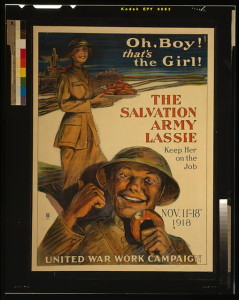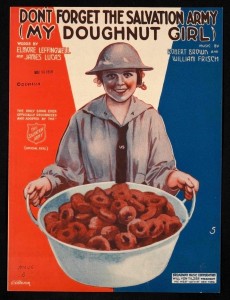Background

The Salvation Army is a staple of American philanthropy today, but it has not always been so well known. Its war work in France, so crucial to the United War Work Campaign’s publicity campaign, earned the Salvation Army fame it had never before known. Founded in 1865 in London by William Booth to minister to the urban poor, the Army did not begin work in America until 1880.[1] As a Protestant organization, the Army was more accepted by mainstream American society than American Jewry or Catholicism. Still, the organization was disliked in its early years and faced opposition at times. The United War Work Campaign may have played upon the Army’s publicity and fame in selling the campaign, but these were new developments for the American Salvation Army.
The Social Gospel
Much of the organization’s animating spirit, as least in America, came from the Social Gospel movement of the late nineteenth century. Prominent figures included Baptist reformer Walter Rauschenbusch, who defended the right of unions to organize and stood for “human life against profits.” He also accused his co-religionists of indifference to the social problems of the day, problems that Jesus and His disciples would have confronted had they lived at the time. In this vein another Social Gospel minister, Charles Sheldon, coined the phrase “What would Jesus do?” as an imperative call for Christians to aid the poor and work for social reform on their behalf. This attitude, which naturally placed less emphasis on doctrine and theology than social work, was often considered suspect by more mainstream Protestant organizations. This was more than just social snobbery, however; the Social Gospel was often perceived as being aligned with racial or socialist politics. The Salvation Army primarily worked with the urban poor, often with no formal theology or physical church space, work that earned it the contempt of other Protestants.[2]
Opposition
Mainline Protestants who saw the Army as too lower-class and radical were not the only opponents of Salvationists.The Army often took away the saloon’s most ardent customers and many Salvationists suffered retaliatory muggings and beatings from saloon-hired thugs.[3] These biases and criticisms leveled against the Army may not have been as virulent as contemporary anti-Semitism and anti-Catholicism, but the organization still was not beloved.
The Army was thus in a precarious position at the time of America’s entrance into the war. The organization had an opportunity much like the one afforded to the Jewish Welfare Board and National Catholic War Council: broader acceptance and a chance to prove patriotism. The Salvation Army did not miss this opportunity and plunged headlong into the war effort, a decision that had huge ramifications on its publicity thereafter.
War Work

The Salvation Army never kept a large number of personnel in France during the war. At any given time, perhaps only 500 or so Salvationists were working at the front.[4] The Army supplied food and coffee to American troops as its primary service. The Salvation Army “doughnut lassies” were the most widely known of the Army’s war workers.[5] These women, who worked tirelessly to prepare doughnuts and coffee for war-weary troops, earned the admiration of the American public. Doughnuts may have made the Army famous, but Salvationists also operated canteens at low rates, transferred funds back to the U.S. for soldiers and served as nurses and chaplains.[6]. The Army was soon one of the most popular organizations at the front. One newspaper declared that “Few war organizations have escaped criticism of some sort, but there is, so far, one shining exception and that is the Salvation Army.” [7] Another reporter, writing in the New York Times, lamented that he had thought lowly of the organization prior to witnessing their war work.[8] Testimonies like these were not uncommon and the reputation of the Army improved significantly throughout the course of the war.
Evangeline Booth
Of all the leaders of the United War Work Campaign, General Evangeline Booth (1865-1950) of the Salvation Army was perhaps the most colorful. Although born and raised in London, she became the public face of the American Salvation Army during one of its most famous eras. Born Evelyn Booth on Christmas Day, 1865, she was the seventh child of William Booth, the founder of the Army. She became involved with the organization at a young age and became the commander of operations in Canada in 1896.[9] In 1904 she came to the United States to assume leadership of the Army’s activities in that country. When war was first declared in 1914, she pledged the Army to war charity. A campaign to collect linens for bandages was launched in that year and collected thousands of pounds worth of linen.[10]
However, when the U.S. entered the war, Evangeline Booth and the Salvation Army went with it. The introduction to The War Romance of the Salvation Army, written by Booth herself in the aftermath of the war, suggests that she sincerely believed in the war effort. “The inhuman monster … has been overthrown. Autocracy and diabolical tyranny lie defeated and crushed…”[11] Her writing suggests that the Salvation Army, or at least its commander, saw themselves in a religious struggle that was closely tied to democracy. Booth also was a capable leader and it was under her leadership that the Army would become perhaps the most famous of all the groups involved in the United War Work Campaign.
[1]Herbert A Wisbey, Soldiers without Swords: A History of the Salvation Army in the United States (New York: Macmillan, 1955).
[2]Edwin Gaustad and Leigh Schmidt, The Religious History of America (New York: HarperCollins Publishers, 2002), 2 41-242, 245.
[3]Wisbey, Soldiers without Swords: A History of the Salvation Army in the United States, 10-40.
[4]Wisbey, Soldiers without Swords: A History of the Salvation Army in the United States, 155-170.
[5]Wisbey, Soldiers without Swords: A History of the Salvation Army in the United States, 159-70.
[6]Wisbey, Soldiers without Swords: A History of the Salvation Army in the United States, 155-170.
[7]Wisbey, Soldiers without Swords: A History of the Salvation Army in the United States, 165.
[8]Wisbey, Soldiers without Swords: A History of the Salvation Army in the United States, 164.
[9]Margaret Troutt,The General Was a Lady: The Story of Evangeline Booth (Nashville: A.J. Holman, 1980), 89-90.
[10]Troutt, The General Was a Lady: The Story of Evangeline Booth, 103.
[11]Evangeline Booth and Grace Livingston Hill, The War Romance of the Salvation Army, 2005, “From the Commander’s Own Pen,” http://www.gutenberg.org/ebooks/7811?msg=welcome_stranger.